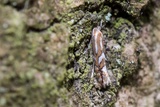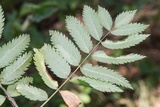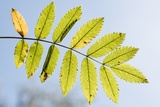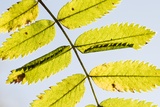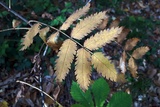Phyllonorycter sorbi (Frey, 1855) Species
Last modified: Dec. 14, 2024, 4:39 p.m.
A widespread and common species in Belgium, especially in the northern part.
Details
- Classification
- Family: Gracillariidae > Subfamily: Lithocolletinae > Genus: Phyllonorycter > Species: Phyllonorycter sorbi
- Vernacular names
- Lijsterbesvouwmot (NL), Rowan midget (EN), Vogelbeeren-Faltenminiermotte (DE)
- Synonyms
- Phyllonorycter sorbifoliella (Herrich-Schäffer, 1855)
- First mention in Belgium
- De Fré Ch. 1858. Catalogue des Microlépidoptères de la Belgique. — Annales de la Société entomologique belge 2: 45–162. On page 158 (as L.[ithocolletis] Sorbifoliella). Tr.). view page
- Status
-
Native
Distribution
Imago
Head brown mixed with some white hairs; forewing ground colour brown, white pattern consisting of a straight basal streak, sometimes finely edged with dark brown scales above; an undefined patch at dorsum near the base; four costal and three dorsal striae edged with dark brown scales basally; some dark brown scales in the apical area.
Mine
An elongated, tentiform mine on the underside of a leaflet, with some distinct longitudinal folds. The mine is much contracted, especially in small leaves where it can even occupy the entire surface. The upperside is yellowish green. The frass is concentrated in a corner of the mine. Depending on the host plant, the mine is parallel with the leaf margin (Sorbus) or it is situated between two secondary veins (Prunus).
See also gracillariidae.net and bladmineerders.be.
Cocoon/pupa
A tough, white cocoon, without applying frass to the spinning. Pupa light brown.
Bionomics
The species hibernates in the pupal stage, between leaf litter on the ground. After emergence of the adult, the pupal skin protrudes through the mine.
Flight periods
The adults fly in two generations a year in May and in August–September.
Observed on
- Host plant (species):
- Sorbus aucuparia and Prunus padus
The larva lives mainly on Sorbus aucuparia, but can occasionally be found on Prunus padus and Sorbus aria; the species has been recorded furthermore on many other Rosaceae, like Chaenomeles, Cotoneaster, Crataegus, Cydonia, and Malus.
